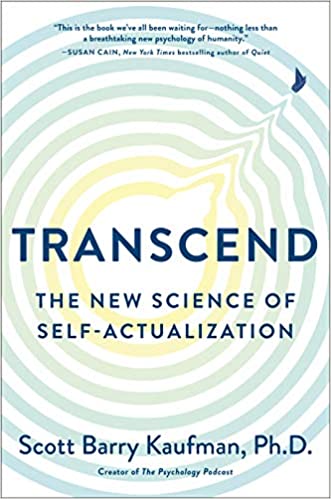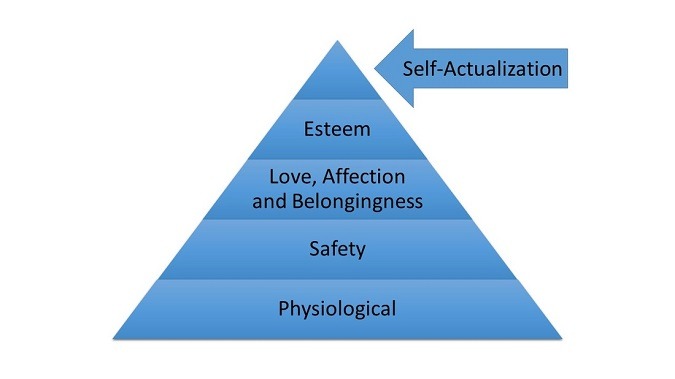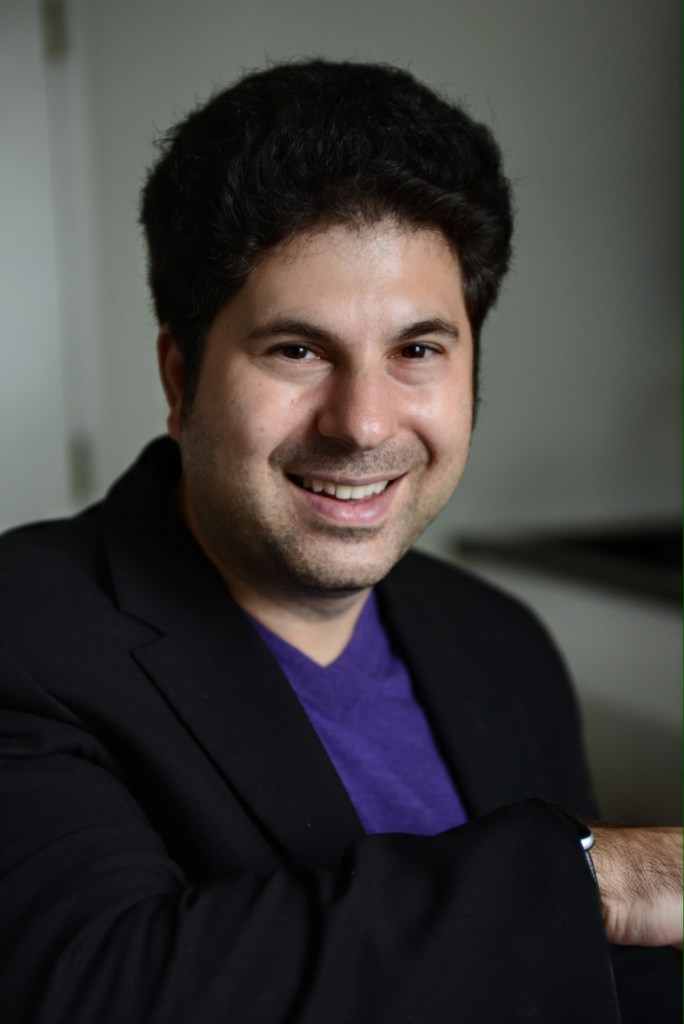Transcending Maslow’s famous “hierarchy of needs” through Maslow’s own research on Peak Experiences
Heaven, so to speak, lies waiting for us through life, ready to step into for a
time and to enjoy before we have to come back to our ordinary life of striving.
And once we have been in it, we can remember it forever, and feed ourselves
on this memory and be sustained in times of stress.—Abraham Maslow, Toward a Psychology of Being (1962)
 After completing Motivation and Personality in 1954, Maslow turned his attention to a particular characteristic of self-actualizing people that long fascinated him. Many of the self-actualizing people he studied tended to sound like traditional mystics, describing unusual moments of heightened joy, serenity, beauty, or wonder. He was surprised, having begun his research under the impression that mystical experiences were rare, something that perhaps “happened to one saint every century.”
After completing Motivation and Personality in 1954, Maslow turned his attention to a particular characteristic of self-actualizing people that long fascinated him. Many of the self-actualizing people he studied tended to sound like traditional mystics, describing unusual moments of heightened joy, serenity, beauty, or wonder. He was surprised, having begun his research under the impression that mystical experiences were rare, something that perhaps “happened to one saint every century.”
Instead, Maslow observed that peak experiences occurred in a wide range of people and seemed to have many triggers—whether an excellent athletic or music performance, creative experience, aesthetic perception, the love experience, sexual experience, childbirth, moments of insight and understanding, religious or mystical experience, or overcoming a profound challenge—“any experience that comes close to perfection.” What’s more, it seemed that the greater a person’s psychological health, the greater the frequency of such experiences, the higher their height, and the greater the intensity and the illumination. Such observations inspired Maslow to generalize the experience and “strip it of its traditionally religious meaning.” In 1954, he was finally ready to take a deep dive into understanding these fascinating human experiences.
It wasn’t an easy path of inquiry. A lifelong atheist, Maslow associated organized religion with dogma and superstition. And although William James treated mystic experiences as a positive experience in his epic 1902 book The Varieties of Religious Experience, James discussed such experiences largely in a religious context. When Maslow announced his intentions to formally study such experiences, he was greeted with skepticism by many of his colleagues. However, as Edward Hoffman put it, “Braving their good-natured sneers, [Maslow] ventured into this territory alone.”
Maslow read widely—from Eastern religious thought, including The First and Last Freedom by Indian philosopher J. Krishnamurti and The Wisdom of Insecurity by Alan Watts, to the literatures of mysticism, religion, art, creativity, and romantic love. He looked at descriptions of the yogic estatic state known as samadhi. He also plumbed Carl Jung’s writings on religion, just then appearing in English translation. Maslow brainstormed examples of the mystic experience under the heading “time-lessness” in his unpublished notes from the summer of 1954. He noted examples of the mystic state, hypnotic trance, aesthetic absorption, and transcendent sex.
Ready to formally study the topic, Maslow designed a phenomenological approach. He gave the following prompt to 190 college students:
I would like you to think of the most wonderful experience or experiences in your life; happiest moments, ecstatic moments, moments of rapture, perhaps from being in love, or from listening to music or suddenly “being hit” by a book or a painting, or from some great creative moment. First list these. And then try to tell me how you feel in such acute moments, how you feel differently from the way you feel at other times, how you are at the moment a different person in some ways.
Maslow also received reports from self-actualizing people whom he knew as well as unsolicited letters from people who had learned of his new research. Soon, he had accumulated more subjective reports on the mystical experience than any other major psychologist since William James. Just as he had done with his self-actualization research, he used the reports and his wide reading of the literature to create “an impressionistic, ideal, ‘composite photograph’” of the “peak experience”—a term he settled on as less religious and more generalizable to the population at large.
 By the spring of 1956, Maslow was so excited by his preliminary findings that he decided to share them with his colleagues. To his shock, the paper was rejected by one top journal after another: Psychological Review, American Psychologist, Psychiatry. He was suddenly aware of how far his research and thinking had gone from mainstream psychology. Undefeated, Maslow offered the article as his address at the 1956 convention of the APA, which had just elected him president of its prestigious Society for Personality and Social Psychology. As the keynote speaker, he was given the freedom to present on whatever topic he wanted.
By the spring of 1956, Maslow was so excited by his preliminary findings that he decided to share them with his colleagues. To his shock, the paper was rejected by one top journal after another: Psychological Review, American Psychologist, Psychiatry. He was suddenly aware of how far his research and thinking had gone from mainstream psychology. Undefeated, Maslow offered the article as his address at the 1956 convention of the APA, which had just elected him president of its prestigious Society for Personality and Social Psychology. As the keynote speaker, he was given the freedom to present on whatever topic he wanted.
Presented on September 1, 1956, Maslow’s lecture was called “Cognition of Being in the Peak Experiences.” He began: “Self-actualizing people, those who have come to a high level of maturation, health, and self-fulfillment, have so much to teach us that sometimes they seem almost like a different breed of human beings. But because it is so new, the exploration of the highest reaches of human nature and of its ultimate possibilities and aspirations is a difficult and tortuous task.”
What was cognition like in the throes of the peak experience, these “transient states of absolute Being”? Maslow outlined seventeen characteristics, including:
• Complete absorption
• Richer perception
• Disorientation in physical time and space
• Intrinsic reward of the experience
• Ego transcendence
• Dichotomy transcendence
• Momentary loss of fears, anxieties, and inhibitions
• Greater acceptance and forgiveness of oneself and others
• Heightened aestheticism, wonder, awe, and surrender
• Fusion of the person and the world
Maslow noticed that for people in their highest moments, the true, the good, and the beautiful “are so highly correlated that for all practical purposes they are said to fuse into a unity.” Maslow believed that if this turned out to be correct, then it would be in direct contradiction to the common assumption in science that the more objective perception becomes, the more detached it becomes from values. “Fact and value have almost always (by intellectuals) been considered to be antonyms and mutually exclusive,” Maslow wrote. “But perhaps the opposite is true, for when we examine the most ego-detached, objective, motivationless, passive cognition, we find that it claims to perceive values directly, that values cannot be shorn away from reality and that the most profound perceptions of ‘facts’ are tinged with wonder, admiration, awe and approval, i.e., with value.”
Maslow believed that peak experiences offer the opportunity to see more of the whole truth, unimpeded by the many cognitive distortions evolved to protect us from psychic pain. In his address, Maslow pointed out an implication: “If self-actualizing people can and do perceive reality more efficiently, fully, and with less motivational contamination than others do, then we may possibly use them as biological assays. Through their greater sensitivity and perception, we may get a better report of what reality is like … just as canaries can be used to detect gas in mines before less sensitive creatures can.”
To be sure, Maslow didn’t believe that peak experiences necessarily lead to a more accurate perception of reality, and he pointed out that further reality testing is necessary. Nevertheless, Maslow noted that peak experiences are often profound and transformative for the person experiencing them. Maslow cited two reports, one from a psychologist and one from an anthropologist, of experiences so intense “as to remove certain neurotic symptoms forever after.” Maslow commented that “the person is more apt to feel that life … is worthwhile, even if it is usually drab, pedestrian, painful, or ungratifying, since beauty, truth, and meaningfulness have been demonstrated to exist.… I think these aftereffects can all be generalized and a feeling of them communicated if the peak-experience could be likened to a visit to a personally defined Heaven from which the person then returns to earth.”
Maslow ended his riveting address by noting that any person in any of the peak experiences can temporarily take on many of the characteristics of self-actualizing people. “For the time they become self-actualizers,” he wrote, “not only are these [their] happiest and most thrilling moments, but they are also moments of greatest maturity, individuation, fulfillment—in a word, [their] healthiest moments.” What really distinguishes self-actualizing people, Maslow argued, is that peak experiences come much more frequently and intensely. “This makes self-actualization a matter of degree and of frequency rather than an all- or- none affair, and thereby makes it more amenable to available research procedures.”
Maslow’s talk was well received, but unfortunately it wasn’t published until 1959, so its broadened reception was delayed. Still, Maslow lectured widely on peak experiences and worked on a book called Religions, Values, and Peak Experiences, which was published in 1964. In that book, Maslow wrote: “The very beginning, the intrinsic core, the essence, the universal nucleus of every known high religion … has been the private, lonely, personal illumination, revelation or ecstasy of some acutely sensitive prophet or seer.…  But it has recently begun to appear that these ‘revelations’ or mystical illuminations can be subsumed under the head of the ‘peak-experiences’ or ‘ecstasies’ or ‘transcendent’ experiences which are now being eagerly investigated by many psychologists.”
But it has recently begun to appear that these ‘revelations’ or mystical illuminations can be subsumed under the head of the ‘peak-experiences’ or ‘ecstasies’ or ‘transcendent’ experiences which are now being eagerly investigated by many psychologists.”
Today, the scientific investigation of transcendent experiences is, in my view, one of the most exciting frontiers in the science of well-being.
– Adapted from the new book Transcend: The New Science of Self-Actualization by Scott Barry Kaufman, with permission of TarcherPerigee, an imprint of Penguin Publishing Group, a division of Penguin Random House LLC. Scott Barry Kaufman is a cognitive scientist interested in the development of intelligence, creativity, and personality. Copyright © Scott Barry Kaufman, 2020. You can order the book HERE.


